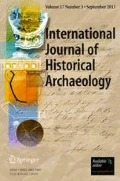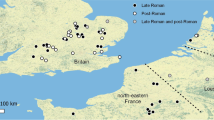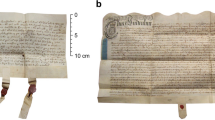Abstract
This paper seeks to revisit the debate concerning the nature and timing of the British Agricultural Revolution. Specifically, it considers how zooarchaeological evidence can be employed to investigate later-medieval and post-medieval “improvements” in animal husbandry. Previous studies of animal bone assemblages have indicated that the size of many domestic species in England increases from the fifteenth century—an observation that has been used to support the writings of those historians that have argued that the Agricultural Revolution occurred several centuries prior to the traditionally ascribed date of 1760–1840. Here, zooarchaeological data are presented which suggest that the size of cattle, sheep, pig and domestic fowl were increasing from as early as the fourteenth century. However, it is argued that the description of these changes as revolutionary is misleading and disguises the interplay of factors that influenced agricultural practice in the post-Black Death period. This paper concludes with a plea for greater awareness of the value of collecting and analysing faunal data from the eighteenth and nineteenth centuries to enable the historically attested productivity increases of the traditionally dated Agricultural Revolution to be examined archaeologically.
Similar content being viewed by others
References
Albarella, U. (1997). Size, power and veal: Zooarchaeological evidence for late medieval innovations. In de Boe, G. and Verhaeghe, F. (eds.), Environment and Subsistence in Medieval Europe: Papers of the ‘Medieval Europe Brugge 1997’ Conference Volume 9, I.A.P. Rapporten 9, Zellik, pp. 19–30.
Albarella, U. (2002). ‘Size matters’: How and why biometry is still important in zooarchaeology. In Dobney, K. and O'Connor, T. P. (eds.), Festschrift for Don Brothwell, Oxbow Books, Oxford, pp. 51–62.
Albarella, U., and Davis, S. (1996). Mammals and birds from Launceston Castle, Cornwall: Decline in status and the rise of agriculture. Circaea 12: 1–156.
Albarella, U., and Payne, S. (2005). Neolithic pigs from Durrington Walls, Wiltshire, England: A biometrical database. Journal of Archaeological Science 32: 589–599.
Albarella, U., Beech, M., and Mulville, J. (1997). The Saxon, Medieval and Post-Medieval Mammal and Bird Bones Excavated 1989–1991 from Castle Mall, Norwich, Norfolk, Ancient Monuments Laboratory Report 72/97, London.
Allen, R. C. (1991). The two English Agricultural Revolutions, 1450–1850. In Campbell, B. and Overton, M. (eds.), Land, Labour and Livestock: Historical Studies in European Agricultural Productivity, Manchester University Press, Manchester, pp. 236–254.
Andrews, A., and Noddle, B. (1975). Absence of premolar teeth from ruminant mandibles found at archaeological sites. Journal of Archaeological Science 2: 137–144.
Beckett, J. V. (1990). The Agricultural Revolution, Basil Blackwood Ltd., Oxford.
Boland, P. (1984). Dudley Castle Archaeological Project—First Interim Report (1983–1984). West Midlands Archaeology 27: 1–20.
Bull, G., and Payne, S. (1988). Components of variation in measurements of pig bones and teeth, and the use of measurements to distinguish wild from domestic pig remains, Archaezoologia 2: 27–65.
Campbell, B. M. S., and Overton, M. (1993). A new perspective on medieval and early modern agriculture: Six centuries of Norfolk farming, c.1250–c.1850. Past and Present 141: 38–105.
Chambers, J. D., and Mingay, G. E. (1966). The Agricultural Revolution 1750–1880, B. T. Batsford, London.
Cossette, E., and Horad-Herbin, M.-P. (2003). A contribution to the morphometrical study of cattle in Colonial North America. Journal of Archaeological Science 30: 263–274.
Davis, S. J. M. (1992). A Rapid Method for Recording Information about Mammal Bones from Archaeological Sites, Ancient Monuments Laboratory Report 19/92, London.
Davis, S. J. M. (1996). Measurements of a group of adult female Shetland sheep skeletons from a single flock: A baseline for zooarchaeologists. Journal of Archaeological Science 23: 593–612.
Davis, S. J. M. (1997). The Agricultural Revolution in England: Some zooarchaeological evidence. Anthropozoologica 25/ 26: 413–428.
Davis, S. J. M., and Beckett, J. V. (1999). Animal husbandry and agricultural improvement: The archaeological evidence from animal bones and teeth. Rural History 10: 1–17.
Dyer, C. C. (1981). Warwickshire Farming 1349–c.1520: Preparations for Agricultural Revolution, Dugdale Society Occasional Papers No. 27, Oxford.
Dyer, C. C. (1997). Medieval farming and technology: Conclusion. In Astill, G. and Langdon, J. (eds.), Medieval Farming and Technology: The Impact of Agricultural Change in Northwest Europe, Brill, Leiden, pp. 293–312.
Dobney, K., Jaques, S. D., and Irving, B. G. (1996). Of Butchers and Breeds: Report on Vertebrate Remains from Various Sites in the City of Lincoln, Lincoln Archaeological Studies No. 5. Technical Print Services, Nottingham.
von den Driesch, A. (1976). A Guide to the Measurement of Animal Bones from Archaeological Sites, Peabody Museum Bulletin 1, Harvard University.
Ernle, L. (1912). English Farming Past and Present, Longmans, Green, London.
Fock, J. (1966). Metrische Untersuchungen an Metapodien einiger Europäischer Rinderrasen, Unpublished dissertation, University of Munich, Munich.
Higham, C. (1969). The metrical attributes of two samples of bovine limb bones. Journal of Zoology 157: 63–74.
Higham, C., and Message, M. (1969). An assessment of a prehistoric technique of bovine husbandry. In Brothwell, D. and Higgs, E. (eds.), Science in Archaeology: A Survey of Progress and Research (2nd ed.), Thames and Hudson, London, pp. 315–330.
Hopcraft, R. L. (1994). The social origins of agrarian change in late medieval England. The American Journal of Sociology 99(6): 1559–1595.
Johnson, M. (1996). An Archaeology of Capitalism, Blackwell, Oxford.
Kerridge, E. (1967). The Agricultural Revolution, Allen and Unwin, London.
Kerridge, E. (1969). The Agricultural Revolution reconsidered. Agricultural History 43: 463–476.
Meadow, R. (1999). The use of size index scaling techniques for research on archaeozoological collections from the Middle East. In Becker, C., Manhart, H., Peters, J. and Schibler, J. (eds.), Historia Animalium ex Ossibus. Festschrift für Anglea von den Driesch, Verlag Marie Leidorf GmbH, Rahden/Westf, pp. 285–300.
Miles, A. E. W., and Grigson, C. (1990). Colyer's Variations and Diseases of the Teeth of Animals, Cambridge University Press, Cambridge.
Mingay, G. E. (1969). Dr. Kerridge's “Agricultural Revolution”: A comment. Agricultural History 42: 477–482.
Mingay, G. E. (1989). The Agrarian History of England and Wales Volume VI, 1750–1850, Cambridge University Press, Cambridge.
O'Connor, T. P. (2000). The Archaeology of Animal Bones, Sutton, Stroud.
Overton, M. (1984). Agricultural revolution? Development of the agrarian economy in early modern England. In Baker, A. R. H. and Gregory, D. (eds.), Explorations in Historical Geography: Interpretative Essays, Cambridge University Press, Cambridge, pp. 118–235.
Overton, M. (1996a). Re-establishing the English Agricultural Revolution. Agricultural History Review 44: 1–34.
Overton, M. (1996b). Agricultural Revolution in England: The Transformation of the Agrarian Economy 1500–1850, Cambridge University Press, Cambridge.
Rackham, O. (1986). The History of the Countryside: The Classic History of Britain's Landscape, Flora and Fauna, Dent, London.
Reitz, E., and Ruff, B. (1994). Morphometric data for cattle from North America and the Caribbean prior to the 1850s. Journal of Archaeological Science 21: 699–713.
Thirsk, J. (1987). England's Agricultural Regions and Agrarian History in England, 1500–1700, Macmillan Education, Basingstoke.
Thomas, R. N. W. (1988). A statistical examination of criteria used in sexing cattle metapodials. Archaeozoologia 2: 83–92.
Thomas, R. (1999). Feasting at Worcester Cathedral in the seventeenth century: A zooarchaeological and historical approach. Archaeological Journal 156: 342–358.
Thomas, R. (2002). Animals, Economy and Status: The Integration of Historical and Zooarchaeological Data in the Study of a Medieval Castle, Unpublished Ph.D. thesis, University of Birmingham, Birmingham, UK.
Thomas, R. (2003). The 19th–20th century animal bones from Stafford Castle: An educational collection and a zooarchaeological investigation, Unpublished report.
Thomas, R. (2005). Animals, Economy and Status: Integrating Zooarchaeological and Historical Data in the Study of Dudley Castle, West Midlands (c. 1100–1750), BAR British Series 392. Archaeopress, Oxford.
Trow-Smith, R. (1957). A History of British Livestock Husbandry to 1700, Routledge and Kegan Paul, London.
Turner, M. E., Beckett, J. V., and Afton, B. (2001). Farm Production in England 1700–1914, Oxford University Press, Oxford.
Verhulst, A. (1990). The “Agricultural Revolution” of the Middle Ages reconsidered. In Bachrach, B. S. and Nicholas, D. (eds.), Law, Custom and the Social Fabric of Medieval Europe: Essays in Honor of Bryce Lyon, Medieval Institute Publications, Western Michigan University, Michigan, pp. 17–28.
Williamson, T. (2002). The Transformation of Rural England: Farming and the Landscape 1700–1870, University of Exeter Press, Exeter.
Author information
Authors and Affiliations
Corresponding author
Rights and permissions
About this article
Cite this article
Thomas, R. Zooarchaeology, Improvement and the British Agricultural Revolution. Int J Histor Archaeol 9, 71–88 (2005). https://doi.org/10.1007/s10761-005-8140-9
Issue Date:
DOI: https://doi.org/10.1007/s10761-005-8140-9




